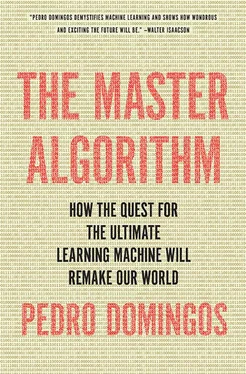Another property of the world that makes learning and inference easier is that the entities in it don’t come in arbitrary forms. Rather, they fall into classes and subclasses, with members of the same class being more alike than members of different ones. Alive or inanimate, animal or plant, bird or mammal, human or not: if we know all the distinctions relevant to the question at hand, we can lump together all the entities that lack them and that can save a lot of time. As before, the MLN doesn’t have to know a priori what the classes in the world are; it can learn them from data by hierarchical clustering.
The world has parts, and parts belong to classes: combining these two gives us most of what we need to make inference in Alchemy tractable. We can learn the world’s MLN by breaking it into parts and subparts, such that most interactions are between subparts of the same part, and then grouping the parts into classes and subclasses. If the world is a Lego toy, we can break it up into individual bricks, remembering which attaches to which, and group the bricks by shape and color. If the world is Wikipedia, we can extract the entities it talks about, group them into classes, and learn how classes relate to each other. Then if someone asks us “Is Arnold Schwarzenegger an action star?” we can answer yes, because he’s a star and he’s in action movies. Step-by-step, we can learn larger and larger MLNs, until we’re doing what a friend of mine at Google calls “planetary-scale machine learning”: modeling everyone in the world at once, with data continually streaming in and answers streaming out.
Of course, learning on this scale requires much more than a direct implementation of the algorithms we’ve seen. For one, beyond a certain point a single processor is not enough; we have to distribute the learning over many servers. Researchers in both industry and academia have intensely investigated how to, for example, do gradient descent using many computers in parallel. One option is to divide the data among the processors; another is to divide the model’s parameters. After each step, we combine the results and redistribute the work. Either way, doing this without letting the cost of communication overwhelm you, or the quality of the results suffer, is far from trivial. Another issue is that, if you have an endless stream of data coming in, you can’t wait to see it all before you commit to some decisions. One solution is to use the sampling principle: if you want to predict who will win the next presidential election, you don’t need to ask every voter who he or she will vote for; a sample of a few thousand suffices, if you’re willing to accept a little bit of uncertainty. The trick is to generalize this to complex models with millions of parameters. But we can do this by taking at each step just as many examples from the stream as we need to be pretty sure that we’re making the right decision and that the total uncertainty over all the decisions stays within bounds. That way we can effectively learn from infinite data in finite time, as I put it in an early paper proposing this approach.
Big-data systems are the Cecil B. DeMille productions of machine learning, with thousands of servers instead of thousands of extras. In the largest projects, just getting all the data together, verifying it, cleaning it up, and munging it into a form the learners can digest can make building the pyramids seem like a walk in the park. At the pharaonic end, Europe’s FuturICT project aims to build a model of-literally-the whole world. Societies, governments, culture, technology, agriculture, disease, the global economy: nothing is to be left out. This is surely premature, but it does foreshadow the shape of things to come. In the meantime, projects like this can help us find out where the limits of scalability are and how to overcome them.
Computational complexity is one thing, but human complexity is another. If computers are like idiot savants, learning algorithms can sometimes come across like child prodigies prone to temper tantrums. That’s one reason humans who can wrangle them into submission are so highly paid. If you know how to expertly tweak the control knobs until they’re just right, magic can ensue, in the form of a stream of insights beyond the learner’s years. And, not unlike the Delphic oracle, interpreting the learner’s pronouncements can itself require considerable skill. Turn the knobs wrong, though, and the learner may spew out a torrent of gibberish or clam up in defiance. Unfortunately, in this regard Alchemy is no better than most. Writing down what you know in logic, feeding in the data, and pushing the button is the fun part. When Alchemy returns a beautifully accurate and efficient MLN, you go down to the pub and celebrate. When it doesn’t-which is most of the time-the battle begins. Is the problem in the knowledge, the learning, or the inference? On the one hand, because of the learning and probabilistic inference, a simple MLN can do the job of a complex program. On the other, when it doesn’t work, it’s much harder to debug. The solution is to make it more interactive, able to introspect and explain its reasoning. That will take us another step closer to the Master Algorithm.
The doctor will see you now
The cure for cancer is a program that inputs the cancer’s genome and outputs the drug to kill it with. We can now picture what such a program-let’s call it CanceRx-will look like. Despite its outward simplicity, CanceRx is one of the largest and most complex programs ever built-indeed, so large and complex that it could only have been built with the help of machine learning. It is based on a detailed model of how living cells work, with a subclass for each type of cell in the human body and an overarching model of how they interact. This model, in the form of an MLN or something akin to it, combines knowledge of molecular biology with vast amounts of data from DNA sequencers, microarrays, and many other sources. Some of the knowledge was manually encoded, but most was automatically extracted from the biomedical literature. The model is continually evolving, incorporating the results of new experiments, data sources, and patient histories. Ultimately, it will know every pathway, regulatory mechanism, and chemical reaction in every type of human cell-the sum total of human molecular biology.
CanceRx spends most of its time querying the model with candidate drugs. Given a new drug, the model predicts its effect on both cancer cells and normal ones. When Alice is diagnosed with cancer, CanceRx instantiates its model with both her normal cells and the tumor’s and tries all available drugs until it finds one that kills the cancer cells without harming the healthy ones. If it can’t find a drug or combination of drugs that works, it sets about designing one that will, perhaps evolving it from existing ones using hill climbing or crossover. At each step in the search, it tries the candidate drugs on the model. If a drug stops the cancer but still has some harmful side effect, CanceRx tries to tweak it to get rid of the side effect. When Alice’s cancer mutates, it repeats the whole process. Even before the cancer mutates, the model predicts likely mutations, and CanceRx prescribes drugs that will stop them dead in their tracks. In the game of chess between humanity and cancer, CanceRx is checkmate.
Notice that machine learning isn’t going to give us CanceRx all by itself. It’s not as if we have a vast database of molecular biology ready to go, stream it into the Master Algorithm, and out pops the perfect model of a living cell. CanceRx would be the end result, after many iterations, of a worldwide collaboration between hundreds of thousands of biologists, oncologists, and data scientists. Most important, however, CanceRx would incorporate data from millions of cancer patients, with the help of their doctors and hospitals. Without that data, we can’t cure cancer; with it, we can. Contributing to this growing database would not only be in every cancer patient’s interest; it would be her ethical duty. In the world of CanceRx, discrete clinical trials are a thing of the past; new treatments proposed by CanceRx are continually being rolled out, and if they work, given to a widening circle of patients. Both successes and failures provide valuable data for CanceRx’s learning, in a virtuous circle of improvement. If you look at it one way, machine learning is only a small part of the CanceRx project, well behind data gathering and human contributions. But looked at another way, machine learning is the linchpin of the whole enterprise. Without it, we would have only fragmentary knowledge of cancer biology, scattered among thousands of databases and millions of scientific articles, each doctor aware of only a small part. Assembling all this knowledge into a coherent whole is beyond the power of unaided humans, no matter how smart; only machine learning can do it. Because every cancer is different, it takes machine learning to find the common patterns. And because a single tissue can yield billions of data points, it takes machine learning to figure out what to do for each new patient.
Читать дальше












